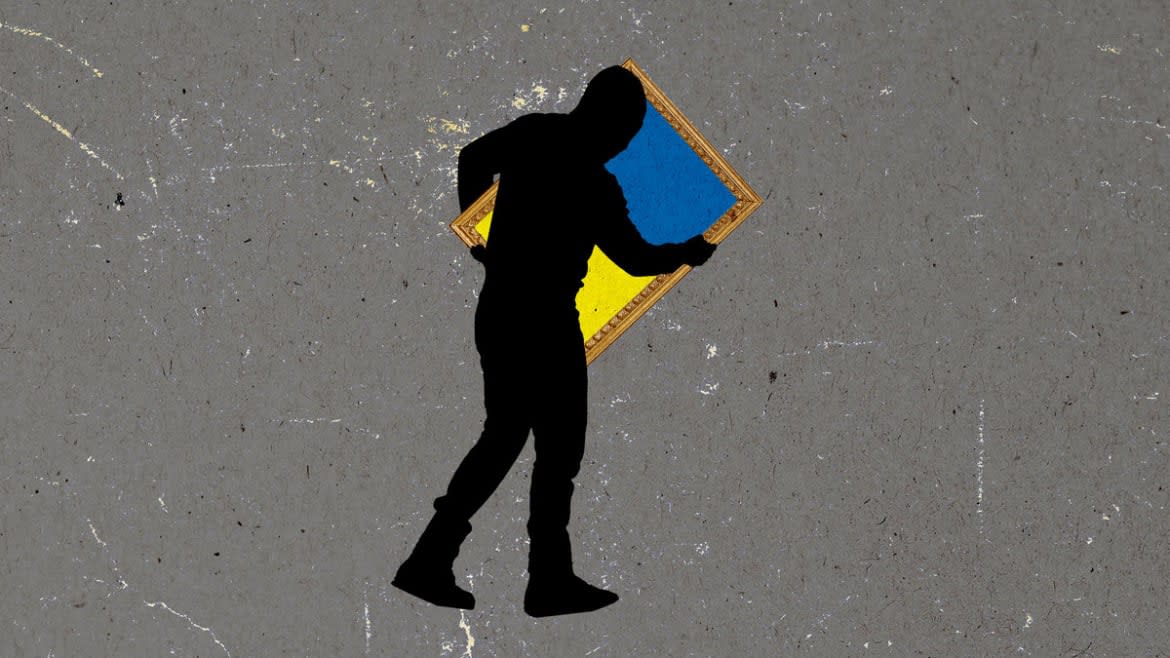Russia Is Pulling Off a Massive Art Heist in Ukraine

The looting of art at times of war dates back millennia, with the Greeks and Romans among the worst perpetrators. Museums and private collections around the world are filled with looted art that changed hands during conflicts. During World War II, a secret Allied army known as the “Monuments Men” worked to protect European treasures from being pilfered by invading armies—with mixed success. Hitler’s stolen treasures are still being discovered across Germany. Millions of stolen pieces may never be found.
So far there are no specially trained armies in Ukraine to protect treasures from the precision Russian art thieves working under the cover of war to empty museums and destroy important pieces of Ukraine’s cultural heritage. There are just brave museum curators in regions where the Russians have seized control doing everything they can to hide and fortify their art and antiquities, using supplies smuggled in from the West to help them crate up paintings and sandbag statues.
Since Russia began its invasion in February, 250 cultural institutions have been targeted by Russian munitions. Thousands of important museums pieces have been destroyed during the bombing of Mariupol and elsewhere. In Melitopol, Scythian gold artifacts worth millions that date back to the fourth century B.C. were stolen from crates the museum had hidden them in.
Brian Daniels, an anthropologist in Virginia, is heading a project that monitors the destruction of cultural heritage in Ukraine. “There is now very strong evidence this is a purposive Russian move, with specific paintings and ornaments targeted and taken out to Russia,” he told The Daily Beast. His team saw surveillance video supplied by Ukraine in which a Russian art expert in a white lab coat removed the gold with the precision of a surgeon, careful not to destroy them. “There is a possibility it is all part of undermining the identity of Ukraine as a separate country by implying legitimate Russian ownership of all their exhibits.”
Art historians are extremely concerned that Russia is stealing the country’s soul by destroying these items. “We have museum buildings destroyed, with all collections turned into ashes—it's quite a barbaric situation,” curator and art historian Konstantin Akinsha, who is an expert in Ukrainian art, told The Roundtable program on Australia’s ABC. “[The] other side of the problem is that in little towns which are occupied by Russians, we have the first cases of random looting of museums.”

An employee walks past a protectively-wrapped display cases and furnitures in one of the galleries of the Potocki Palace, one of the architectural gems of western Ukraine and home of Lviv National Art Gallery in Lviv on May 13, 2022.
In many cases across Ukraine, museum directors have refused to evacuate without their art so are huddling in fortified museums. “Directors cannot leave the building because [they will need to] return at night in case something happens,” Akinsha, who is in touch with many of them, said. “So they became kind of cellar hermits… all around the country.”
Among the destroyed art are 25 pieces by Ukrainian artist Maria Prymachenko which were in the Ivankiv museum near Kyiv. Ukrainian officials say the art was taken by Russian troops before they destroyed the museum in a missile attack.

View from the window of Theater Square, sandbags barricade the sculpture-fountain "Molodist", and the windows of the Museum of the Marine Fleet of Ukraine are covered with boards. Ukrainian authorities in Odessa have installed barricades in the historical center to protect key sites and monuments in the event of Russian bombing or possible street fighting.
The ALIPH Foundation, which has worked tirelessly in conflict zones including Syria and Afghanistan—where untold treasures were destroyed in recent decades—said they are sending supplies like crates, fireproof blankets and packing materials, to Ukrainian museums to help them fortify works in case bombing continues.
“The storage facilities themselves need to be up to standard,” Sandra Bialystok, spokesperson for ALIPH, said in a statement posted on their website. “They need to have proper humidity control, be away from the elements and the packing boxes need to be of a certain caliber in order to protect the artifacts because these artifacts are, of course, precious and fragile.”
Get the Daily Beast's biggest scoops and scandals delivered right to your inbox. Sign up now.
Stay informed and gain unlimited access to the Daily Beast's unmatched reporting. Subscribe now.

